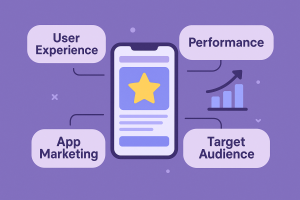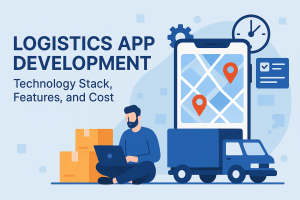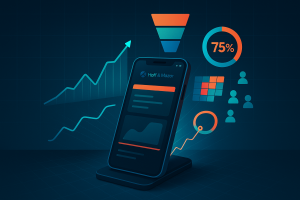Building a mobile app that can handle growing numbers of users, data, and features without buckling under pressure is both an art and a science. Whether you’re launching a startup or working for a large enterprise, understanding how to architect and strategize for scalability is crucial. In this guide, we’ll explain in plain terms what scalability means, why it matters, and how to design your mobile app from the ground up so it remains fast, reliable, and maintainable as you grow. We’ll cover core architectural patterns, backend strategies, performance optimizations, and key tools—plus a handy FAQ to wrap up. Let’s get started!
Why Scalability Matters
Imagine your app suddenly going viral. Traffic spikes, data flows surge, and users expect everything to run smoothly. If your architecture isn’t ready, users face crashes, slowdowns, and outages—leading to bad reviews and lost revenue. Scalable mobile apps ensure:
- Performance at Scale: Fast loading times regardless of user load.
- Reliability: Minimal downtime and graceful degradation under stress.
- Maintainability: Easy to add features without rewriting core logic.
- Cost Efficiency: Resources scale up or down to match real demand.
Scalability isn’t an afterthought; it’s a design philosophy that permeates every layer of your app.
Defining Scalable Mobile App Architecture
At a high level, scalable architecture splits your system into distinct layers:
- Client (Mobile) Layer: The app installed on devices.
- API Layer: A gateway that routes client requests to appropriate services.
- Business Logic Layer: Services or microservices that contain core functionality.
- Data Layer: Databases, caches, and storage systems.
- Infrastructure Layer: Cloud or on‑prem servers, load balancers, and CDNs.
Each layer must be designed to scale independently, preventing bottlenecks.
Client-Side Strategies for Scalability
Offline-First and Data Sync
A scalable app anticipates network disruptions. Offline‑first design means your app stores data locally (e.g., with SQLite or Realm) and syncs with the server when connectivity is restored. Benefits include:
- Resilient UX: Users can continue working offline.
- Efficient Sync: Batched updates reduce server calls.
- Conflict Resolution: Define rules (last-write, merge, user prompts) to handle data conflicts.
Lazy Loading and Pagination
Never load all data at once. Implement pagination for lists and lazy loading for images:
- Infinite Scroll: Load more items as the user scrolls.
- Placeholders: Show skeletons or low‑res thumbnails to improve perceived performance.
These techniques reduce memory usage and network overhead.
Backend Architectures
Monolithic vs. Microservices
Monolithic Architecture:
- All features live in a single codebase and deployable unit.
- Easier to start, but can become unwieldy as you grow.
Microservices Architecture:
- Break functionality into small, independently deployable services.
- Each service scales on its own, improving resilience and speed of development.
- Requires robust service discovery, inter-service communication (e.g., REST, gRPC), and deployment pipelines.
Selecting the right approach depends on your team size, expertise, and growth projections.
Serverless and Function-as-a-Service (FaaS)
Serverless platforms (AWS Lambda, Google Cloud Functions) let you run code without managing servers. You pay per execution, making it cost‑effective for variable workloads. Use serverless for:
- Event-driven tasks: Processing uploads, sending notifications.
- APIs: Build lightweight endpoints without provisioning VMs.
- Cron jobs: Scheduled tasks like database cleanup.
API Gateway Patterns
An API gateway sits between your clients and services, handling:
- Routing: Directs requests to the correct microservice.
- Authentication/Authorization: Verifies tokens or API keys.
- Rate Limiting: Protects backends from overload.
- Caching: Reduces load on services by caching frequent responses.
This centralized pattern simplifies client logic and enhances security.
Data Storage and Management
SQL vs. NoSQL Databases
- SQL (Relational): MySQL, PostgreSQL. Great for structured data and complex queries.
- NoSQL (Document/Key-Value): MongoDB, DynamoDB. Excels at flexible schemas and horizontal scalability.
Often, a hybrid approach works best—SQL for transactional data, NoSQL for unstructured or rapidly changing data.
Caching Layers and CDNs
- In‑Memory Caches: Redis or Memcached store hot data close to your services.
- CDNs (Content Delivery Networks): Distribute static assets (images, videos) globally, cutting latency.
Caching reduces database load and accelerates content delivery.
Performance Optimization Techniques
Speed matters. Slow apps drive users away. Here are strategies:
- Batch API Calls: Combine multiple requests into one.
- Compress Payloads: Use Gzip or Brotli on responses.
- Optimize Images: Serve WebP or responsive images.
- Background Processing: Offload heavy tasks to background threads or serverless functions.
For deeper insights, check out our guide on tips and tricks for mobile app performance optimization.
Load Balancing and Auto-Scaling
Horizontal vs. Vertical Scaling
- Vertical Scaling: Add more CPU or RAM to existing servers.
- Horizontal Scaling: Add more machines. This approach is often preferable for fault tolerance and cost efficiency.
Regional Deployment
Deploying your backends in multiple regions reduces latency for global users. Use DNS-based load balancing or anycast to route users to the nearest data center.
Security and Reliability
Scalability must go hand in hand with security:
- Authentication: JWT, OAuth2 for secure user sessions.
- Encryption: TLS/SSL for data in transit; AES for data at rest.
- Rate Limiting and Throttling: Prevent abuse and DDoS attacks.
- Circuit Breaker Patterns: Fail fast and recover gracefully when downstream services become unhealthy.
Implementing failover and redundancy ensures your app stays up even when individual components fail.
DevOps and CI/CD for Mobile
Automate your builds, tests, and deployments:
- CI/CD Pipelines: Tools like Jenkins, GitHub Actions, or Bitrise can build your app, run tests, and deploy to staging or production.
- Infrastructure as Code (IaC): Terraform or CloudFormation manage your cloud resources reproducibly.
- Monitoring and Alerts: Prometheus, Grafana, or CloudWatch track metrics and alert you to issues before they impact users.
A robust DevOps culture accelerates releases and keeps quality high.
Testing and Monitoring
Automated Testing
- Unit Tests: Validate business logic.
- Widget/UI Tests: Ensure your app’s interface works as expected.
- End-to-End Tests: Tools like Appium simulate user interactions.
Monitoring Tools
- Performance Monitoring: Firebase Performance Monitoring or New Relic Mobile.
- Crash Reporting: Sentry, Crashlytics.
- Real User Monitoring (RUM): Understand how real users experience your app in production.
Continuous testing and monitoring help you catch regressions early and maintain a smooth user experience.
Common Pitfalls to Avoid
Even seasoned teams can stumble. Avoid these pitfalls:
- Skipping Load Testing: Never assume your app can handle real‑world traffic spikes.
- Monolithic Databases: Don’t let your database become a single point of failure.
- Ignoring Network Efficiency: Reckless polling or over‑fetching data kills performance.
- Undocumented APIs: Poor documentation leads to integration headaches for clients.
- Overengineering Early: Optimize architecture for growth, but don’t overspend before you need it.
For further guidance, read about 5 common mistakes to avoid in mobile app development.
Emerging Trends
Edge Computing
Edge services run computation closer to users, slashing latency for real‑time features like AR or gaming. Speaking of AR games, check out inspiring examples of top android augmented reality games.
AI-Driven Backends
AI can optimize resource allocation, predict load spikes, and even handle chatbots and recommendation engines at scale.
Progressive Web Apps (PWAs)
For some scenarios, PWAs offer near‑native experiences with simpler deployment and universal compatibility.
Leveraging Expert Teams
Scaling a mobile app can be complex. If you need specialized help:
- An Offshore Mobile App Development Company can provide cost-effective engineering talent.
- For interactive, high-performance games, partner with the best mobile game developers.
- Teams recognized among the top mobile game developers bring proven expertise in building reliable, scalable experiences.
Getting Started with App Architecture
If you’re just starting out, nail down your architecture early:
- Define Modules: Break your app into clean, independent modules.
- Choose Tech Stack: Align your framework choices (e.g., Flutter, React Native, native).
- Prototype: Build a vertical slice to validate choices.
Learn foundational principles in mobile app architecture: how to start building.
Resources for Beginners
New to mobile development? Check out mobile app development: a guide for beginners for step‑by‑step advice on your first app.
FAQ
What are the key benefits of a microservices architecture for mobile apps?
Microservices allow independent scaling, easier deployments, and fault isolation—if one service fails, others continue running. This granularity boosts reliability.
How do I choose between SQL and NoSQL databases?
Use SQL for structured, relational data and complex queries. Choose NoSQL for flexible schemas, high write volumes, and horizontal scaling needs.
What is an API gateway, and why do I need one?
An API gateway centralizes routing, authentication, rate limiting, and caching. It simplifies client integration and protects backend services.
How can I test my app’s scalability before launch?
Use load testing tools like JMeter or Gatling to simulate concurrent users, and stress test your backend to find breaking points.
When should I consider serverless over microservices?
Serverless shines for event-driven tasks, unpredictable workloads, and when you want to minimize infrastructure management. It may not suit long‑running tasks or heavy computation.
Conclusion
Building scalable mobile apps starts with thoughtful architecture and a clear strategy. By adopting client‑side optimizations like offline‑first design, choosing the right backend pattern—be it microservices or serverless—and layering in caching, load balancing, and DevOps best practices, you can ensure your app grows gracefully with your user base. Avoid common traps by planning for performance, security, and maintainability from the outset. With these foundations, your mobile app will be ready to delight millions without breaking a sweat.







